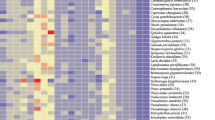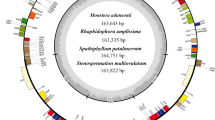Abstract
The trnL-trnF region is located in the large single-copy region of the chloroplast genome. It consists of the trnL gene, a group I intron, and the trnL-F intergenic spacer. We analyzed the evolution of the region in three gymnosperm families, Taxaceae, Cephalotaxaceae, and Podocarpaceae, with especially dense sampling in Taxaceae and Cephalotaxaceae, for which we sequenced 43 accessions, representing all species. The trnL intron has a conserved secondary structure and contains elements that are homologous across land plants, and the spacer is highly variable in length and composition. The spatial distribution of nucleotide diversity along the trnL-F region suggests that different portions of this region have different evolutionary patterns. Tandem repeats that form stem–loop structures were detected in both the trnL intron and the trnL-F spacer, and the spacer sequences contain promoter elements for the trnF gene. The presence of promoters and stem–loop structures in the trnL-F spacer and high sequence variation in this region suggest that trnL and trnF are independently transcribed. Stem–loop regions P6, P8, and P9 of the trnL intron and the trnL-F spacer (except the promoter elements) might undergo neutral evolution with respect to their escape from functional constraints.






Similar content being viewed by others
References
Benson G (1999) Tandem Repeats Finder: a program to analyze DNA sequences. Nucleic Acids Res 27:573–580
Benson G and Dong L (1999) Reconstructing the duplication history of a tandem repeat. In: Lengauer T, Schneider R, Bork P, Brutlag D, Glasgow J, Mewes H-W and Zimmer R (eds) Proceedings of the seventh international conference on intelligent systems for molecular biology. AAAI Press, Menlo Park, CA, pp 44–53
Besendahl A, Qiu Y-L, Lee J, Palmer JD, Bhattacharya D (2000) The cyanobacterial origin and vertical transmission of the plastid tRNALeu group-I-intron. Curr Genet 37:12–23
Bonnard G, Michel F, Weil JH, Steinmetz AA (1984) Nucleotide sequence of the split tRNALeu gene from Vicia faba chloroplasts: evidence for structural homologies of the chloroplast tRNALeu intron with the intron from the autosplicable Tetrahymena ribosomal RNA precursor. Mol Gen Genet 194:330–336
Borsch T, Hilu KW, Quandt D, Wilde V, Neinhuis C, Barthlott W (2003) Noncoding plastid trnT-trnF sequences reveal a well resolved phylogeny of basal angiosperms. J Evol Biol 16:558–576
Cech TR (1990) Self-splicing of group I introns. Annu Rev Biochem 59:543–568
Cech TR, Damberger SH, Gutell RR (1994) Representation of the secondary and tertiary structure of group I introns. Nat Struct Biol 1:273–280
Cheng Y, Nicolson RG, Tripp K, Chaw SM (2000) Phylogeny of Taxaceae and Cephalotaxaceae genera inferred from chloroplast matK gene and nuclear rDNA ITS region. Mol Phylogenet Evol 14:353–365
Chiang YC, Schaal BA, Ge XJ, Chiang TY (2004) Range expansion leading to departures from neutrality in the nonsymbiotic hemoglobin gene and the cpDNA trnL-trnF intergenic spacer in Trema dielsiana (Ulmaceae). Mol Phylogenet Evol 31:929–942
Cozzolino S, Cafasso D, Pellegrino G, Musacchio A, Widmer A (2003) Molecular evolution of a plastid tandem repeat locus in an orchid lineage. J Mol Evol 57(Suppl 1):S41–S49
Hao DC, Huang B, Yang L (2008) Phylogenetic relationships of the genus Taxus inferred from chloroplast intergenic spacer and nuclear coding DNA. Biol Pharm Bull 31:260–265
Hong L, Stevenson JK, Roth WB, Hallick RB (1995) Euglena gracilis chloroplast psbB, psbT, psbH and psbN gene cluster: regulation of psbB-psbT pre-mRNA processing. Mol Gen Genet 247:180–188
Koch MA, Dobes C, Matschinger M, Bleeker W, Vogel J, Kiefer M, Mitchell-Olds T (2005) Evolution of the trnF(GAA) gene in Arabidopsis relatives and the Brassicaceae family: monophyletic origin and subsequent diversification of a plastidic pseudogene. Mol Biol Evol 22:1032–1043
Levinson G, Gutman GA (1987) Slipped-strand mispairing: a major mechanism for DNA sequence evolution. Mol Biol Evol 4:203–221
Li J, Davis CC, Tredici PD, Donoghue MJ (2001) Phylogeny and biogeography of Taxus (Taxaceae) inferred from sequences of the internal transcribed spacer region of nuclear ribosomal DNA. Harv Pap Bot 6:267–274
Morton BR, Oberholzer VM, Clegg MT (1995) Neighbouring base composition is strongly correlated with base substitution bias in a region of the chloroplast genome. J Mol Evol 41:227–231
Posada D (2006) ModelTest Server: a web-based tool for the statistical selection of models of nucleotide substitution online. Nucleic Acids Res 34:W700–W703
Quandt D, Müller K, Stech M, Hilu KW, Frey W, Frahm J-P, Borsch T (2004) Molecular evolution of the chloroplast trnL-F region in land plants. Monogr Syst Bot Mo Bot Gard 98:13–37
Ronquist F, Huelsenbeck JP (2003) MrBayes 3: Bayesian phylogenetic inference under mixed models. Bioinformatics 19:1572–1574
Rozas J, Sanchez-DelBarrio JC, Messeguer X, Rozas P (2003) DnaSP, DNA polymorphism analyses by the coalescent and other methods. Bioinformatics 19:2496–2497
Schaal BA, Olsen KM (2000) Gene genealogies and population variation in plants. Proc Natl Acad Sci USA 97:7024–7029
Simon D, Fewer D, Friedl T, Bhattacharya D (2003) Phylogeny and self-splicing ability of the plastid tRNA-Leu group I intron. J Mol Evol 57:710–720
Simonsen KL, Churchill GA, Aquadro CF (1995) Properties of statistical tests of neutrality for DNA polymorphism data. Genetics 141:413–429
Stech M, Quandt D, Frey W (2003) Molecular circumscription of the hornworts (Anthocerotophyta) based on the chloroplast DNA trnL-trnF region. J Plant Res 116:389–398
Swofford DL (2002) PAUP: phylogenetic analysis using parsimony (and other methods). Version 4. Sinauer Associates, Sunderland, Massachusetts
Taberlet P, Gielly L, Pautou G, Bouvet J (1991) Universal primers for amplification of three non-coding regions of chloroplast DNA. Plant Mol Biol 17:1105–1109
Taberlet P, Coissac E, Pompanon F, Gielly L, Miquel C, Valentini A, Vermat T, Corthier G, Brochmann C, Willerslev E (2007) Power and limitations of the chloroplast trnL (UAA) intron for plant DNA barcoding. Nucleic Acids Res 35:e14
Tajima F (1989) Statistical methods to test for nucleotide mutation hypothesis by DNA polymorphism. Genetics 123:585–595
Tamura K, Dudley J, Nei M, Kumar S (2007) Mega4: molecular evolutionary genetics analysis (MEGA) software version 4.0. Mol Biol Evol 24:1596–1599
Wakasugi T, Tsudzuki J, Ito S, Nakashima K, Tsudzuki T, Sugiura M (1994) Loss of all ndh genes as determined by sequencing the entire chloroplast genome of the black pine Pinus thunbergii. Proc Natl Acad Sci USA 91:9794–9798
Wang T, Su Y-J, Zheng B, Li X-Y, Zang Q-L, Qu L-J, Gu HY (2003) Cladistic analysis of chloroplast rbcL gene and trnL/trnF intergenic spacer sequences in Taxaceae and related taxa. In: Sharma AK, Sharma A (eds) Plant genome: biodiversity and evolution, vol. 1. part A. Phanerogams. Scientific Publications, Enfield, NH, pp 103–116
Wang XQ, Shu YQ (2000) Chloroplast matK gene phylogeny of Taxaceae and Cephalotaxaceae, with additional reference to the systematic position of Nageia. Acta Phytotax Sinica 38:201–210
Won H, Renner SS (2006) Dating dispersal and radiation in the gymnosperm Gnetum (Gnetales)-clock calibration when outgroup relationships are uncertain. Syst Biol 55:610–622
Zaug AJ, McEvoy MM, Cech TR (1993) Self-splicing of the group I intron from Anabaena pre-tRNA: requirement for base-pairing of the exons in the anticodon stem. Biochemistry 32:7946–7953
Zhang D, Dirr MA, Price RA (2000) Discrimination and genetic diversity of Cephalotaxus accessions using AFLP Markers. J Amer Soc Hortic Sci 125:404–412
Zhu Y, Queller DC, Strassmann JE (2000) A phylogenetic perspective on sequence evolution in microsatellite loci. J Mol Evol 50:324–338
Zuker M (2003) Mfold web server for nucleic acid folding and hybridization prediction. Nucleic Acids Res 31:3406–3415
Zwickl DJ (2006) Genetic algorithm approaches for the phylogenetic analysis of large biological sequence datasets under the maximum likelihood criterion. Ph.D. dissertation, University of Texas, Austin
Acknowledgments
We thank the following experts for providing plant materials: Yunfen Geng (Yunnan Academy of Forestry, Kunming, China), Qing Wang (Wuhan Botanical Garden, Chinese Academy of Sciences, China), Yinke Zhang (Hangzhou Botanical Garden, Zhejiang, China), Li Xu (Chinese Academy of Tropical Agriculture, Danzhou, Hainan, China), Yan Liu (Guangxi Institute of Botany, Guilin, China), Didier Maerki (Arboretum de Villardebelle, France), Christopher Quinn (Royal Botanic Garden, Sydney, Australia), Ron Determann (Atlanta Botanical Garden, USA), Robert G. Nicolson (Smith College, USA), Duang Buddhasukh (Chiang Mai University, Thailand), Richard W. Spjut (World Botanical Associates, California, USA), Stephane Bailleul (Montreal Botanical Garden, Canada), Bob Ursem (Botanic Garden, Delft University of Technology, The Netherlands), and James Stevenson (University of Oxford Botanic Garden, UK). This study was supported by the Start-up doctoral fund of Dalian Jiaotong University.
Author information
Authors and Affiliations
Corresponding author
Electronic supplementary material
Below is the link to the electronic supplementary material.
Fig. S1
Variation of length and secondary structure of the stem-loop region P8 of the trnL intron (648 KB).
Fig. S2
Examples of stem-loop structures observed upstream of trnF GAA, including elements of the putative sigma70-type promoter found in the trnL-F spacer (italicized). Transcription start sites are shown in boldface and larger font (2.69 MB).
Rights and permissions
About this article
Cite this article
Hao, D.C., Huang, B.L., Chen, S.L. et al. Evolution of the Chloroplast trnL-trnF Region in the Gymnosperm Lineages Taxaceae and Cephalotaxaceae. Biochem Genet 47, 351–369 (2009). https://doi.org/10.1007/s10528-009-9233-7
Received:
Accepted:
Published:
Issue Date:
DOI: https://doi.org/10.1007/s10528-009-9233-7




